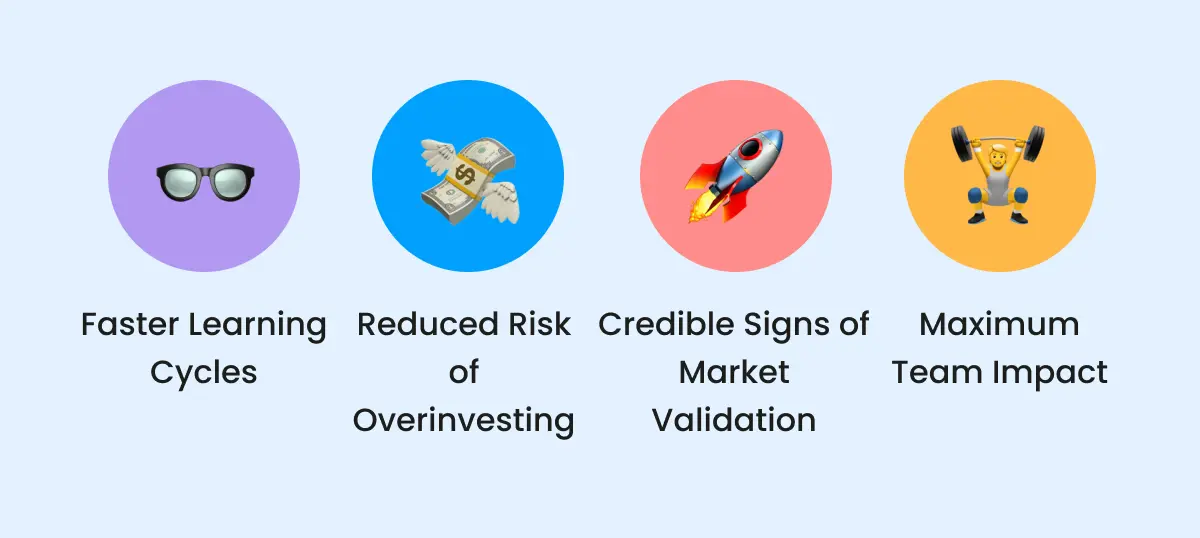What is a Minimum Viable Product (MVP) - Guide 2025
Nov 7, 2024 • 9 min read
What is a Minimum Viable Product (MVP)?
A minimum viable product is a limited set of functionalities wrapped in a single offering that delivers value to a customer.
The “minimal” part of the definition tells us that if you remove anything from the product, it will no longer be viable. In other words, the product is not excessive.
The “viable” piece is about building a product that customers can use and that allows them to learn from their experience.
The MVP is an important milestone in developing your product as it marks the first time you ship an actual product to customers. Ideally, you had many other opportunities to learn before the MVP in the form of user tests, proof of concepts, prototypes, a landing page, etc. Still, all these illustrated your product conceptually, adding significant limitations to what it can do.
The MVP is when the rubber hits the road, and you will get real-world feedback from (potential) customers about your real product. This is the moment to collect the maximum amount of validated learnings about your customers.
What is the Purpose of the Minimum Viable Product?
The goal at the MVP stage is to learn as fast as possible. Chances are that you didn’t get everything right on the first attempt, and you need to adjust your product to achieve product-market fit. The faster you iterate over your MVP, the more learnings you will extract, and the faster you will be ready to move to the next versions of your new product.
Benefits of the MVP for Your Lean Startup
Building a Minimum Viable Product helps companies avoid overinvesting in their new products before they have high confidence in their success based on the feedback from the market.
There are many horror stories about multiyear products that consumed millions of investments and decades of manhours just to be released and get no traction at all.
While big companies can often afford that and recover from such missteps, this might be a deadly mistake for a small startup or even a growing scaleup company. That’s why it's so important to ship the minimal version of the product so that you can build it as quickly as possible and get user feedback.
In short, the benefits you can expect from using MVP on your way to product-market fit are:
- Faster learning cycles
- Reduced risk of overinvesting in a product with no potential for win,
- Getting the most out of your talent’s time,
- Credible signs of market validation like first revenue, referrals, and customer retention.

Minimum Viable Product Examples
There are many strategies for limiting the scope of your product to achieve its “minimality.” We will use Spotify to illustrate various techniques that you can also use.
Focusing on Core Functionality
In the first versions of Spotify, users could only use the product's core functionality—extremely fast music streaming—without downloading, podcasting, or audiobooks. This strategy allowed the product team to validate customer demand with the least effort.
Pick a Specific Market
Spotify launched first in Sweden, a natural step for a Swedish-based company. Later, it gradually expanded to different countries in Europe. It took Spotify years to enter the US market, which made a real difference in its need to become a market leader.
In the music industry, many country-specific aspects related to copyrights and intellectual property laws need to be addressed, and trying to launch in too many countries before having real-world validation about the product value would be a complete overkill.
Simple Business Model
Today, Spotify has a subscription-based business model with various offerings for individual and family users. But they started simple—a freemium offering that allowed them to easily reach the mass market and quickly validate their value proposition with a significant number of users.
Starting with a paid and free product has many pros and cons. In Spotify's case, the free plan allowed quick market validation and strong virality factors to reinforce its growth.
Partnerships
A key component of Spotify's business model is its partnership with music labels. Spotify could have started negotiating with all of them, but instead, it picked one that would provide enough validation and impact to get traction and nailed it. That partnership later created a strong tailwind for others to join them.
How to Design Your MVP Using Selected Components of the Business Model Canvas?
Following Spotify’s example, we can extract a simple framework for identifying your MVP using Lean Canvas as a foundation.
Customer Segment
Pick a customer segment or a buyer persona, and you will be in the best position to win. This might mean you have easy access to that segment or understand better their needs. This is the so-called beachhead segment of your early adopters, which you use as a stepping stone to win other segments later.
Here are some questions to ask yourself when picking the right segment:
- Who experiences the product most acutely?
- Which segment is easiest to reach and engage?
- Where is the least competition? This relates well with the Blue Ocean Strategy.
- Which customer segment can help generate word-of-mouth and social proof?
Customer Problem
Chances are that during your product discovery, you identified multiple customer problems that you can tackle. If you have done customer interviews, they will indicate how each customer problem stack ranks for different segments and how painful it is for the respective audience. Understanding the impact of not solving the customer problem for potential customers can also indicate their propensity to pay and the likelihood of switching to a new solution.
Ideally, for your MVP, you need to pick just one customer problem, the most pressing one for the customer segment you decided to tackle.
Here are a few questions to guide you when picking the customer problem to tackle:
- Which problem is most painful and urgent for the custom segment? Picking an urgent and painful problem will increase the chances of potential customers considering a new solution.
- How often is the customer problem experienced?
- Which problem are you in the best position to address with the capabilities, skills, and experience that you have?
- Solving which problem will lead to a meaningful business model with enough growth potential?
- What is the likelihood of customers to consider and switch
Traction Channels
Knowing your target customers and the problem you are solving for them, you need to identify a traction channel with enough potential to generate strong momentum.
The answer to this question is again in your customer interviews. Asking how customers find solutions to their problems today will hint at where and when you need to be so potential customers can discover the right time and place to consider your product.
Revenue and Cost
The revenue and cost structure are key pieces of your business model. You want to pick a strategy that facilitates your goals during the MVP and has a clear path to scale later.
For example, launching a free product should have a clear path to monetization later. Ideally, you can generate revenue from day one of your MVP, a strong signal of product-market fit. Many amazing products launch for free and never achieve market success, as customers have no good reason to pay for them, which eventually leads to the end of the product.
Phases of Iteration of Your MVP
Phase 1: Ideation and Design
You need a solid plan to execute your MVP efficiently. Based on the customer discovery work you have already done and the information from your Lean Canvas, prepare the scope and requirements for your MVP to win the initial customer segment.
The best way to do that is in collaboration with the product designer and software engineers, as they will provide valuable context about which requirements will cost significant time and effort and should deprioritized or simplified.
Also, bringing the whole product team on board from the beginning will ensure alignment and reduce the back-and-forth later on.
Phase 2:Build
After the plan is done, it’s time to build. To ensure an interactive and adaptive approach, make sure you embrace agile development practices and avoid the waterfall development method.
As the product owner, you need to be deeply involved in the build process to clarify requirements, make decisions regarding scope reduction, and support the team while delivering the product.
Phase 3:Launch
Next, the product is ready for launch. Based on the traction channels you picked for your MVP, create a go-to-market strategy that ensures your product is surfaced to the right audience at the right time and with the right messaging to resonate with them.
Phase 4:Assess and Adjust
A key reason for startups to fail is to skip this step and move on to adding more features and scaling the product. After the MVP is launched, assess its success and capture customer feedback.
It’s very rare to nail the product from the first attempt. It’s expected to find areas of improvement or even serious gaps in your initial version that must be addressed. Adjust as needed and repeat the process until you have high confidence that the product is solving the customer problem that you have identified.
Wrap Up
Building an MVP on your way to PMF is a key phase of your product's evolution. Following this approach will help you speed up your learning process and prevent you from scaling the product before it’s ready.
Nailing the scope of the MVP is finicky work and can be done with a deep understanding of the customer segments and their pain points. The Icanpreneur platform provides a structured approach for entrepreneurs and product builders to identify their customers, problems, and value propositions and combine them in a successful product strategy.
FAQs
Both the Minimum Viable Product and the Minimum Valuable Product are related to the Lean Startup methodology. The original term was Minimum Viable Product, but the term Minimum Valuable Product gained popularity by focusing on the value that the MVP delivers to the customer.
Author
Product @ Icanpreneur. Coursera instructor, Guest Lecturer @ Product School and Telerik Academy. Angel Investor. Product manager with deep experience in building innovative products from zero to millions of users.
